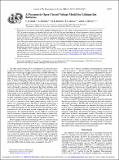A parametric open circuit voltage model for lithium ion batteries
Abstract
We present an open circuit voltage (OCV) model for lithium ion (Li-ion) cells, which can be parameterized by measurements of the OCV of positive and negative electrode half-cells and a full cell. No prior knowledge of physical parameters related to particular cell chemistries is required. The OCV of the full cell is calculated from two electrode sub-models, which are comprised of additive terms that represent the phase transitions of the active electrode materials. The model structure is flexible and can be applied to any Li-ion cell chemistry. The model can account for temperature dependence and voltage hysteresis of the OCV. Fitting the model to OCV data recorded from a Li-ion cell at 0°C, 10°C, 20°C, 30°C and 40°C yielded high accuracies with errors (RMS) of less than 5 mV. The model can be used to maintain the accuracy of dynamic Li-ion cell models in battery management systems by accounting for the effects of capacity fade on the OCV. Moreover, the model provides a means to separate the cell's OCV into its constituent electrode potentials, which allows the electrodes’ capacities to be tracked separately over time, providing an insight into prevalent degradation mechanisms acting on the individual electrodes.
Citation
Birkl , C R , McTurk , E , Roberts , M R , Bruce , P G & Howey , D A 2015 , ' A parametric open circuit voltage model for lithium ion batteries ' , Journal of The Electrochemical Society , vol. 162 , no. 12 , pp. A2271-A2280 . https://doi.org/10.1149/2.0331512jes
Publication
Journal of The Electrochemical Society
Status
Peer reviewed
ISSN
0013-4651Type
Journal article
Description
The financial support of EPSRC UK and Jaguar Land Rover Ltd is gratefully acknowledged.Collections
Items in the St Andrews Research Repository are protected by copyright, with all rights reserved, unless otherwise indicated.

